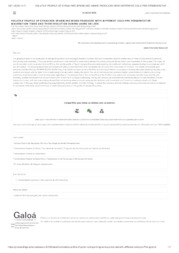Volatile profile of syrah red sparkling wines produced with different cold pre-fermentative maceration times and their evolution during aging on lees.
Volatile profile of syrah red sparkling wines produced with different cold pre-fermentative maceration times and their evolution during aging on lees.
Author(s): BARROS, A. P. A.; SILVA, I. S.; CANDIDO, F.; WAGNER, R.; BIASOTO, A. C. T.
Summary: The growing interest in the production of red sparkling wines has encouraged research into their chemical composition and the contributions of these characteristics to enhance their quality and complexity. This study aimed to evaluate a novel method for winemaking red sparkling wines, using pre-fermentation cold maceration of the grapes. The impact of pre-fermentation cold maceration time (at 8ºC) on the volatile profile of ‘Syrah’ red sparkling wine elaborated by the traditional method was assessed during the autolysis period (3 and 18 months). The following treatments were tested: NM: without cold maceration; M24: maceration for 24 hours; M72: maceration for 72 hours. The volatile compounds were extracted and identified by HS-SPME-GC/FID-GC/MS. Sixty-five volatile compounds were identified and semi-quantified in the samples, including aldehydes, terpenes, ketones, acids, alcohols, and esters, with the latter three classes being more abundant, notably the esters. The use of cold maceration promoted higher concentrations of esters such as ethyl octanoate, ethyl decanoate, and ethyl hexanoate, regardless of the autolysis time of the red sparkling wines. Furthermore, esters such as isoamyl acetate, hexyl acetate, and phenethyl acetate decreased their concentrations after 18 months of autolysis. Additionally, twenty-one compounds presented concentrations above the odor threshold, and the hierarchical cluster and heat map analysis showed that red sparkling wines produced using pre-fermentation cold maceration and 3 months of autolysis stood out in these compounds. In this way, these sparkling wines may potentially exhibit greater aromatic intensity. To assess the accuracy of these findings, a sensory evaluation should be considered to complement this study about the impact of winemaking practices on the quality of red sparkling wines.
Publication year: 2023
Types of publication: Abstract in annals or event proceedings
Unit: Embrapa Environment
Keywords: Autolysis, Odor compounds, Odor-active compounds, Traditional Method, Vinho
Observation
Some of Embrapa's publications are published as ePub files. To read them, use or download one of the following free software options to your computer or mobile device. Android: Google Play Books; IOS: iBooks; Windows and Linux: Calibre.
Access other publications
Access the Agricultural Research Database (BDPA) to consult Embrapa's full library collection and records.
Visit Embrapa Bookstore to purchase books and other publications sold by Embrapa.

